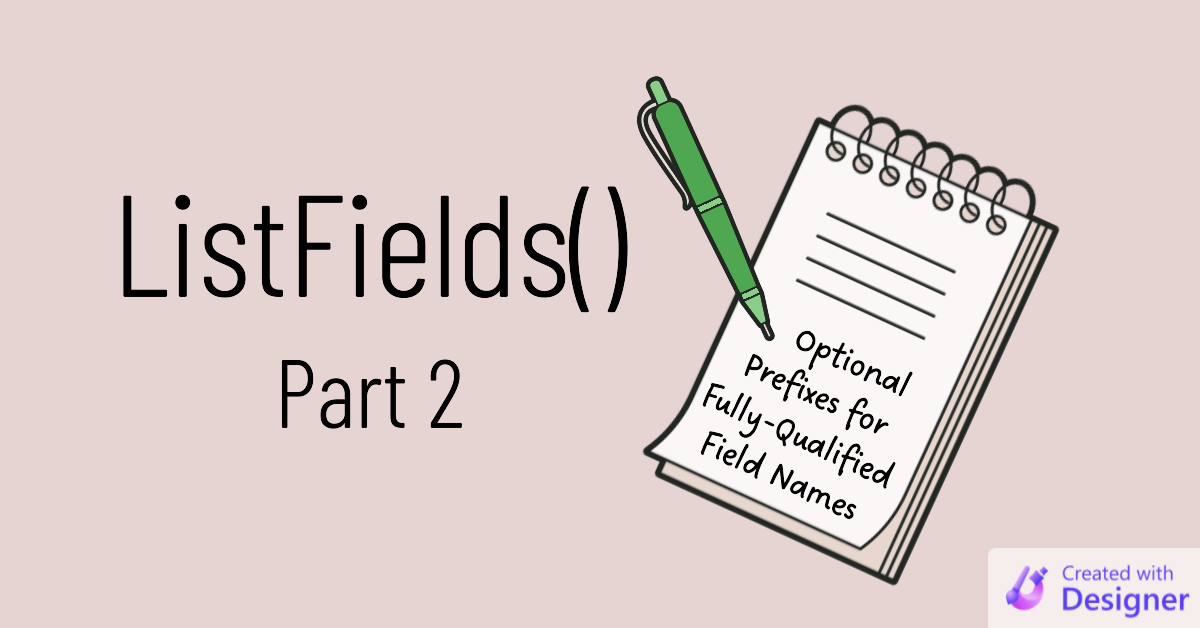ListFields() Part 2: An Optional Prefix
The ListFields() routine expands to include optional table/alias prefixes for outputting fully qualified field names.

In part 1 of this series, we started simple:
In its first incarnation, the ListFields function takes a single argument–the table name–and outputs a list of all the fields in that table.I used the routine in this simple form for several weeks until I started running into a common problem. I would often copy the field names from the immediate window and paste them into my code when I was building SQL strings. This worked especially well for SELECT clauses. Sometimes, though, the query included multiple JOINed tables. In those situations, I would need to add a table name or alias as a prefix to every field.
Going back through the list of fields and adding a prefix to each field got old fast, so I added an optional parameter to prepend each field with a table name or alias.
The Approach
In part two, we're adding an optional String parameter to the ListFields routine. When passed, the parameter will get prepended to each field name.
Subroutine Changes
Here are the changes we are making in this second iteration of the ListFields routine:
- Add argument:
Optional Prefix As String = "" - Change the line...
NewItem = Flds(i).Name
...to...NewItem = Conc(Prefix, Flds(i).Name, ".")
The Full Code
The code below includes required helper functions that I've written about in the past:
- Come Together (the
Conc()function)
The code also requires a reference to the DAO library, which is checked by default on newer versions of Access.
The code below can be copied and pasted into a blank standard module to get a fully-working solution that you can easily integrate into your projects:
' ----------------------------------------------------------------
' Procedure : ListFields
' Date : 12/6/2022 - 12/7/2022
' Author : Mike Wolfe
' Source : https://nolongerset.com/listfields-part2/
' Purpose : Print a comma-delimited list of fields to the
' immediate window to reduce cognitive load from
' context switching between code and application windows.
' Part 2 - Add optional Prefix argument to fully qualify field names
' ----------------------------------------------------------------
Sub ListFields(TblName As String, _
Optional Prefix As Variant = Null)
Const MaxLineLength As Integer = 80
Dim Db As DAO.Database
Set Db = CurrentDb
Dim Flds As DAO.Fields
Set Flds = Db.TableDefs(TblName).Fields
'Loop through all the fields in the table
Dim i As Integer, FldList As String
For i = 0 To Flds.Count - 1
Dim NewItem As String
NewItem = Conc(Prefix, Flds(i).Name, ".")
'If the next item will exceed the max line length,
' then print the line and clear the FldList for the next line
If Len(FldList) + Len(", ") + Len(NewItem) > MaxLineLength Then
Debug.Print FldList
FldList = vbNullString
End If
FldList = Conc(FldList, NewItem)
Next i
'Print the last line to the immediate window
Debug.Print FldList & vbCrLf
End Sub
'---------------------------------------------------------------------------------------
' Procedure : Conc
' Author : Mike Wolfe
' Date : 1/23/2009 - 4/1/2015
' Source : https://nolongerset.com/come-together/
' Purpose : Concatenates two strings
' Notes : Eliminates the need to strip off the leading/trailing delimiter when
' building a string list
'---------------------------------------------------------------------------------------
'
Function Conc(StartText As Variant, NextVal As Variant, _
Optional Delimiter As String = ", ") As String
If Len(Nz(StartText)) = 0 Then
Conc = Nz(NextVal)
ElseIf Len(Nz(NextVal)) = 0 Then
Conc = StartText
Else
Conc = StartText & Delimiter & NextVal
End If
End FunctionSample Usage

Further reading


